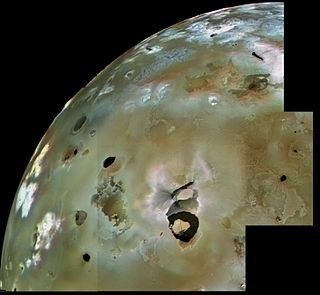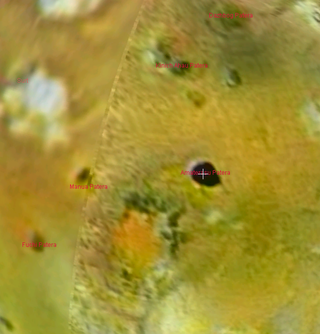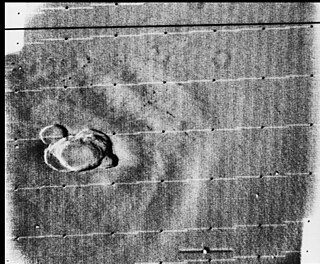
Syrtis Major Planum is a massive shield volcano in the eastern hemisphere of Mars. A "dark spot", Syrtis Major Planum is located in the boundary between the northern lowlands and southern highlands of Mars just west of the impact basin Isidis in the Syrtis Major quadrangle. It was formerly believed to be a plain, and was therefore described as a planitia. Later data from the Mars Global Surveyor revealed that it is actually a broad topographic rise. The dark color of Syrtis Major Planum comes from the basaltic volcanic rock of the region and the relative lack of dust.

Loki Patera is the largest volcanic depression on Jupiter's moon Io, 202 kilometres (126 mi) in diameter. It contains an active lava lake, with an episodically overturning crust. The level of activity seen is similar to a superfast spreading mid-ocean ridge on Earth. It is the largest volcano on Io, producing about 10% of Io’s total thermal emission. Temperature measurements of thermal emission at Loki Patera taken by Voyager 1's Infrared Interferometer Spectrometer and Radiometer (IRIS) instrument were consistent with sulfur volcanism.

Amaterasu Patera is a patera, a complex crater with scalloped edges, on Jupiter's moon Io. It is one of the darkest features on Io, and the measurement of its thermal spectrum helped to support an anticorrelation between albedo and temperature for Ionian hotspots. The feature has darkened further since the first orbit around Jupiter by the Galileo spacecraft. It is 100 kilometers in diameter and located at 38.1°N 306.5°W. It was named after the Japanese sun goddess Amaterasu. To the north are Kinich Ahau Patera and Dazhbog Patera, and to the west are Manua Patera and Fuchi Patera.

Asha Patera is a patera, or a complex crater with scalloped edges, on Jupiter's moon Io. It is approximately 108 kilometers in diameter and located at 8.84°S 225.69°W. It is named after asha, the Zoroastrian principle of Truth. Its name was adopted by the International Astronomical Union in 1979. Reiden Patera and Kami-Nari Patera can both be found to the west.

Kami-Nari Patera is a patera, or a complex crater with scalloped edges, on Jupiter's moon Io. It is approximately 53 kilometers in diameter and is located at 8.7°S 235.08°W. It is named after the Japanese god of rolling thunder, Kami-Nari. Its name was adopted by the International Astronomical Union in 2000. Reiden Patera can be found to the south, and Asha Patera can be found to the east.

Fuchi Patera is a patera, or a complex crater with scalloped edges, on Jupiter's moon Io. It is approximately 66 kilometers in diameter and is located at 28.4°N 327.6°W. It is named after the Ainu fire goddess, Kamuy Fuchi. Its name was adopted by the International Astronomical Union in 1979. Manua Patera is located north-northeast, and Amaterasu Patera is located northeast.

Kinich Ahau Patera is a patera, or a complex crater with scalloped edges, on Jupiter's moon Io. It is about 45 kilometers in diameter and is located at 49.35°N 310.25°W. It is named after the Mayan sun god Kinich Ahau. Dazhbog Patera is located northeast, Amaterasu Patera is located south-southeast, and Manua Patera can be found southwest.

Monan Patera is a patera, or a complex crater with scalloped edges, on Jupiter's moon Io. It is about 137 kilometers in diameter and is located at 19.82°N 104.81°W. It is named after Monan, a god in Brazilian mythology that destroyed the world with fire and floods. Its name was adopted by the International Astronomical Union in 1997.

Ah Peku Patera is a patera, or a complex crater with scalloped edges, on Jupiter's moon Io. It is 85 kilometers in diameter and is located at 10.3°N 107°W. It is named after the Mayan thunder god Ah Peku. Its name was adopted by the International Astronomical Union in 2006. Ah Peku Patera is located on the south end of Monan Mons, north of which is Monan Patera. The eruptive centers Amirani and Maui can be found northwest, as well as Maui Patera. Gish Bar Patera is located toward the northeast. Ah Peku Patera was first detected by the spacecraft Galileo's Solid State Imager and Near-Infrared Mapping Spectrometer. It is considered an active hot spot.

Gish Bar Patera is a patera, or a complex crater with scalloped edges, on Jupiter's moon Io. It is 106.3 by 115.0 kilometers and 9,600 km2 in area. It is located at 16.18°N 90.26°W. It is named after the Babylonian sun god Gish Bar. Its name was approved by the International Astronomical Union in 1997. It is located at the southern base of Gish Bar Mons, an 11-kilometer-high mountain. To the northeast is Skythia Mons, and to the east is Monan Mons, at the north and south ends of which are Monan Patera and Ah Peku Patera.

Estan Patera is a patera, or a complex crater with scalloped edges, on Jupiter's moon Io. It is 95 kilometers in diameter and located at 21.53°N 87.59°W. It is named after the Hittite sun god Estan. Its name was adopted by the International Astronomical Union in 2006. It is located at the northern base of the 11-kilometer mountain Gish Bar Mons. Located west-northwest is Skythia Mons, and to the southwest is Monan Mons, at the northern and southern ends of which are Monan Patera and Ah Peku Patera.

Shango Patera is a patera, or a complex crater with scalloped edges, on Jupiter's moon Io. It is about 90 kilometers in diameter and is located at 32.35°N 100.52°W. It is named after the Yoruba thunder god Shango. Its name was approved by the International Astronomical Union in 2000. It is located north of Skythia Mons. To the southwest is the eruptive center Amirani, and to the southeast are Gish Bar Patera, Gish Bar Mons, and Estan Patera.

Maui Patera is a patera, or a complex crater with scalloped edges, on Jupiter's moon Io. It is about 38 kilometers in diameter and is located at 16.61°N 124.23°W. It is named after Māui, a Hawaiian demigod that sought fire from Mafuike. Its name was approved by the International Astronomical Union in 1979. It is located southwest of the eruptive center Maui, south of Euxine Mons, and southwest of the volcano Amirani. Due east are Monan Patera, Monan Mons, and Ah Peku Patera.

Babbar Patera is a patera, or a complex crater with scalloped edges, on Jupiter's moon Io. It is about 86 kilometers in diameter and is located at 39.8°S 272°W. It is named after a Sumerian sun god, and its name was approved by the International Astronomical Union in 1979. Some scarps near Babbar Patera may represent faults. Immediately south of Babbar Patera is the plateau Lyrcea Planum, and further south is Svarog Patera. To the east is the mountain Egypt Mons.

Svarog Patera is a patera, or a complex crater with scalloped edges, on Jupiter's moon Io. It is 124 kilometers in diameter and is located at 48.66°S 265.74°W. It is named after the Russian smith god Svarog. Its name was approved by the International Astronomical Union in 1979. Svarog Patera is a Voyager spacecraft-detected hot spot. North of Svarog Patera is Lyrcea Planum, north of which is Babbar Patera. To the south is Silpium Mons, and to the east is Hermes Mensa. To the southeast are Pyerun Patera and Epaphus Mensa.

Pyerun Patera is a patera, or a complex crater with scalloped edges, on Jupiter's moon Io. It is about 57 kilometers in diameter and is located at 55.65°S 251.06°W. It is named after the Slavonic god of thunder, Pyerun. The name was adopted by the International Astronomical Union in 1985. West of Pyerun Patera is Mithra Patera, and to the east is the mesa Epaphus Mensa. To the northeast is Epaphus Mensa, and to the northwest are the mountain Silpium Mons and Svarog Patera.

Mithra Patera is a patera, or a complex crater with scalloped edges, on Jupiter's moon Io. It is about 34 kilometers in diameter and is located at 59.04°S 266.48°W. It is named after the Persian god of light, Mithra. Its name was adopted by the International Astronomical Union in 1985. To the north is Silpian Mons, and to the east is Pyerun Patera. Located southwest is Viracocha Patera.

Viracocha Patera is a patera, or a complex crater with scalloped edges, on Jupiter's moon Io. It is about 61 kilometers in diameter and is located at 61.75°S 280.07°W. It is named after the Quechua creator god Viracocha. The name was adopted by the International Astronomical Union in 1979. Viracocha Patera is a Voyager spacecraft-detected hot spot. To Viracocha Patera's east-northeast is Mithra Patera, and to the northeast is the mountain Silpium Mons.

Volcanic activity, or volcanism, has played a significant role in the geologic evolution of Mars. Scientists have known since the Mariner 9 mission in 1972 that volcanic features cover large portions of the Martian surface. These features include extensive lava flows, vast lava plains, and, such as Olympus Mons, the largest known volcanoes in the Solar System. Martian volcanic features range in age from Noachian to late Amazonian, indicating that the planet has been volcanically active throughout its history, and some speculate it probably still is so today. Both Mars and Earth are large, differentiated planets built from similar chondritic materials. Many of the same magmatic processes that occur on Earth also occurred on Mars, and both planets are similar enough compositionally that the same names can be applied to their igneous rocks.

Nili Patera is a dune field on Mars. It is located on top of a lava bed, at the site of an ancient volcano, the Nili Patera caldera of Syrtis Major, near the Martian equator, and it is one of the most active dune fields of Mars. Its location coordinates on Mars are 8.7° N latitude, 67.3° E longitude. It is being actively studied by the HiRISE camera, on board the Mars Reconnaissance Orbiter, at the rate of one image every six weeks. The study of the movement of the dunes provides information regarding wind variation as a function of time and furthers the study of surface erosion characteristics of the Martian landscape. This information can then be used for the development and design of future Mars expeditions. The dunes of the Patera field are of the barchan type and their study by HiRISE was the first one to establish dune and ripple movement of a minimum of 1 metre on Mars. The Patera dune field, was also the first to be investigated using the COSI-Corr software, which was originally developed to analyse the movement of earthbound dunes. The research results from the evidence provided by the monitoring of the Nili Patera field, indicate sand fluxes of the order of several cubic metres per metre per year, similar to the flux observed at the sand dunes of Victoria Valley in Antarctica.














